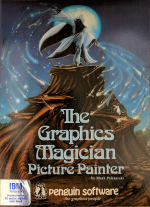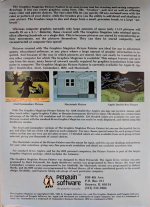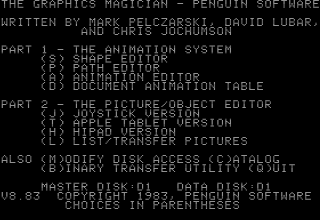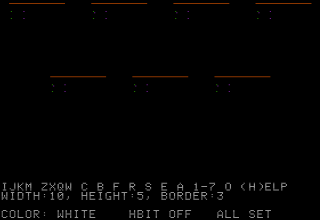Graphics Magician
 Graphics Magician Cover | |||
| Latest Version: | |||
|---|---|---|---|
| Release Date: | 1982-1986 | ||
| Company: | Penguin Software | ||
| Publication Status: | |||
| Developer(s): | Mark Pelczarski | ||
| Interface: | {{{Interface}}} | ||
| Language: | C | ||
| Open Source: | |||
| Source Availability: | |||
| License: | |||
| Type: | Graphics | ||
| Platform: | Apple II, PCjr, Atari 8-bit, C-64 | ||
| Localization: | English | ||
| Website: | |||
Description

|
Jim Leonard[1] wrote:
The Graphics Magician by Penguin Software was the graphics editor that was used to create all of the vector graphics in the Polarware and Penguin Software titles such as Transylvania and The Crimson Crown. The Apple II version is common; the PC version is so rare that I wasn't able to find it until a few years ago even after asking Mark Pelczarski for a copy (who had forgotten it even existed, because he hired a PC programmer to port it) |
About
The Graphics Magician, subtitled Picture Painter, is a utility for drawing bitmapped images and playing them back from user-developed programs. It was written for the Apple II by Penguin Software founder Mark Pelczarski and Jon Niedfeldt,[3] and published by Penguin Software, 1982. It was ported to the Atari 8-bit family, Commodore 64, and IBM PC. The routines for playing back graphics and animation were written by David Lubar and Chris Jochumson.[4] Graphics Magician doesn't store images in their final form, but records the commands used to create them using a "tiny vector graphics-like language."[4] The software plays them back to re-create the image. Images can be layered based on when each shape is drawn.[3]
The Graphics Magician was used to generate images for some commercial graphic adventures of the 8-bit computer era, including Dragon's Keep from Sierra On-Line,[5] Crypt of Medea from Sir-Tech, and Penguin's own The Quest. The playback routines were free to use in commercial products, but required a license from Penguin Software.[3] The Dragon's Keep manual specifically gives credit to Graphics Magician and the authors of the graphics functions.[5]
History
Pelczarski worked as a high school and college professor in computer science. When he got the Apple II, he decided to see what could be done with the new color display. At first, his small skills were swapped for computer supplies at various shops.[6] In 1979 he started selling a precursor to The Graphics Magician called Magic Paintbrush.[4] This was followed by The Complete Graphics System, The Complete Graphics System II, and finally The Graphics Magician.[4]
Older Wikipedia Entry
Graphics Magician was a graphics engine for the Apple II by Penguin Software. Created by Mark Pelczarski, it was one of the first graphical engines ever released. The program also had one of the first open contracts, costing nothing but requiring the user to put Mark's name in the credits.
Development
Pelczarski worked as a high school and college professor in computer science. When he got the Apple II, he decided to see what could be done with the new color display. At first, his small skills were swapped for computer supplies at various shops.[6]
After a few years, he started Penguin Software, and released Graphics Magician to users. The contract for use of the new program was free. In fact, there was no copy protection program to stop anyone from using it. The game maker had to place the programmers, and the company name in the credits.[5]
Graphics Magician was released for the Atari 8-bit[8] computer system, as well as the Commodore 64
Use
The program did not store pictures directly. It would record the instructions to make a picture. The pictures could be layered based on when it was drawn. There was also an early animation program that allowed a character to appear in different places. This rudimentary animation would be used later in Shockwave and Adobe Flash.
It used joysticks, mouse, and keyboard commands to make art.[3] The strokes would be recorded, and then replayed at the time of command.
A game maker would record a picture, and then name it. When the game needed it, the creator would activate the name. This allowed pictures to be made
Legacy
Penguin Software released several games on their own. The major use however was from other users. Such games as Dragon's Keep, or the Transylvania series would not be made without the use of the graphical engine.
It was also one of the first animation programs.
Screenshots

|

|
Features
Usage
Games using The Graphics Magician
References
- ↑ Big Box PC Game Collectors Facebook Group Graphics Magician Thread
- ↑ Graphics Magician entry on Wikipedia
- ↑ 3.0 3.1 3.2 3.3 The Graphics Magician Manual Template:PDF
- ↑ 4.0 4.1 4.2 4.3 The Graphics People Penguin Software
- ↑ 5.0 5.1 5.2 Dragon's Keep Manual Template:PDF
- ↑ 6.0 6.1 "Software Wizard Creates Colorful Animation With Magician". Chicago Tribune. March 1, 1985
- ↑ Earlier Wikipedia Entry
- ↑ Antic 9/84